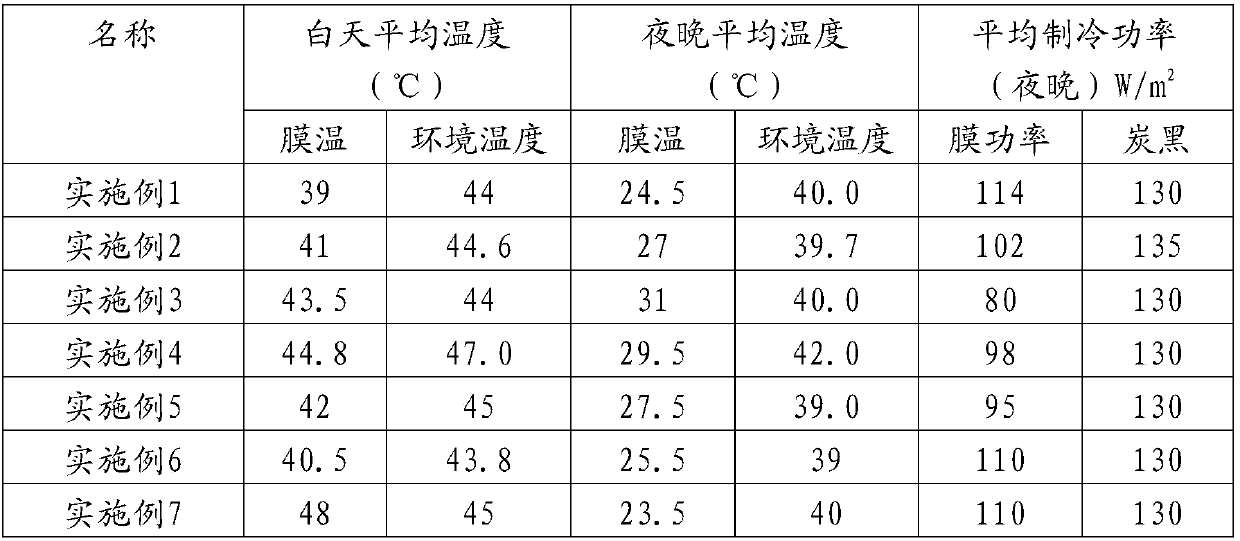Composite film and preparation method thereof
A composite film, polymer material technology, applied in the direction of ion implantation plating, coating, metal material coating process, etc., can solve the problems of complex lithography technology, high brittleness of composite materials, covering and other problems
- Summary
- Abstract
- Description
- Claims
- Application Information
AI Technical Summary
Problems solved by technology
Method used
Image
Examples
preparation example Construction
[0052] On the other hand, an embodiment of the present invention provides a method for preparing a composite membrane as described above, including:
[0053] Dispersing the radiator in a solution of a transparent base material, and performing molding treatment to obtain a transparent base film in which the radiator is dispersed;
[0054] The radiator includes a radiator of a first band and a radiator of a second band, the infrared emission peak of the radiator of the first band is located in or covers the range of the first band of the infrared radiation band, and the radiator of the second band The infrared emission peak is located or covered in the second band range of the infrared radiation band, wherein the first band range refers to the band range of 8-10um, and the second band range refers to the band range of 10-13um; and The average emissivity of the first waveband radiator and the second waveband radiator in the infrared radiation waveband are both greater than or equ...
Embodiment 1
[0073] In Example 1, the first waveband radiator is selected from silicon dioxide powder with a particle size of 2 microns, the second waveband radiator is selected from silicon dioxide powder with a particle size of 7 microns, and the transparent base material is selected from TPX.
[0074] 1. Preparation of casting solution:
[0075] Disperse silicon dioxide powder with a particle size of 2 microns and silicon dioxide powder with a particle size of 7 microns in cyclohexane at a volume ratio of 1:2, and ultrasonically 30 min at room temperature to form a uniform dispersion. Stir at 50-70°C for 12 hours and dissolve in the dispersion to form a casting solution. Wherein, the mass percentage of TPX in the casting solution is 15%, the mass percentage of silicon dioxide powder is 6%, the mass percentage of solvent cyclohexane is 79%, the silicon dioxide powder and TPX The volume ratio is 15:100.
[0076] 2. Preparation of a transparent base film dispersed with radiators:
[007...
Embodiment 2
[0081] In Example 2, the first waveband radiator is selected from silica microbeads with a particle size of 3 microns, the second waveband radiator is selected from PVC, and the transparent base material is TPX.
[0082] 1. Surface treatment of inorganic filler silica beads:
[0083] Alcoholyze the silane coupling agent (KH570) under acidic or alkaline conditions for 1 hour, add silica microbeads with a particle size of 3 microns to a mixed solvent of cyclohexane and chloroform, and react at 70°C for 4 hours , and suction-filtered and dried to obtain the surface-treated inorganic filler.
[0084] 2. Preparation of casting solution:
[0085] Disperse the treated silica microbeads in a mixed solvent of cyclohexane and chloroform, ultrasonicate at room temperature for 30 minutes to form a uniform dispersion, and dissolve PVC and TPX in the said Casting fluid is formed in the dispersion. Wherein, the mass percentage of TPX in the casting solution is 15%, the mass percentage of ...
PUM
| Property | Measurement | Unit |
|---|---|---|
| thickness | aaaaa | aaaaa |
| thickness | aaaaa | aaaaa |
| particle diameter | aaaaa | aaaaa |
Abstract
Description
Claims
Application Information
 Login to View More
Login to View More - R&D
- Intellectual Property
- Life Sciences
- Materials
- Tech Scout
- Unparalleled Data Quality
- Higher Quality Content
- 60% Fewer Hallucinations
Browse by: Latest US Patents, China's latest patents, Technical Efficacy Thesaurus, Application Domain, Technology Topic, Popular Technical Reports.
© 2025 PatSnap. All rights reserved.Legal|Privacy policy|Modern Slavery Act Transparency Statement|Sitemap|About US| Contact US: help@patsnap.com



